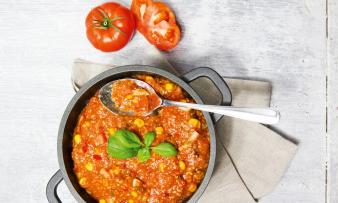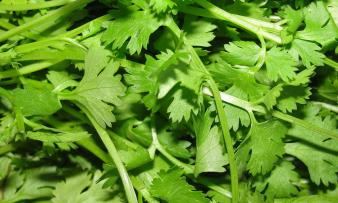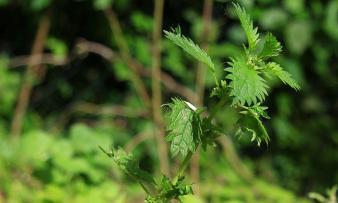Vitamin C (ascorbic acid)
Conclusion:
Vegans who mainly eat fruits, berries, and vegetables have a diet many times richer in vitamin C than people who eat a “normal” diet.
Vitamin C, also known as ascorbic acid, is the most important water-soluble vitamin and antioxidant in the body. It has a wide variety of important functions in the human body.
Occurrence:
Ascorbic acid occurs naturally in many forms. The most important natural sources of vitamin C are fruits and vegetables.1,2 According to the USDA6, the following foods have the highest levels of vitamin C:
| Ingredient | Vitamin C Content (mg/100g)6 | Ingredient | Vitamin C Content (mg/100g)6 |
| Acerola cherry | 1678 | Black currants | 181 (177) |
| Dried cilantro | 567 | Dried wild garlic | 179 |
| Seaberry | 450 | Fresh thyme | 160 |
| Rose hip | 426 | Wild garlic | 150 |
| Hot green chili pepper | 242 | Red chili peppers | 144 |
| Guava | 228 | Drumstick pods | 141 |
| Yellow bell pepper | 184 | Ground elder | 140 |
Other fruits and vegetables worth mentioning for being rich in vitamin C include pointed peppers (140), orange peel (136), pokeweeds, fresh sprouts (136), parsley (1331,1596), fresh komatsuna (130), fresh Siberian kale (130), lemon peel (129), fresh bell peppers (128), kale (120), kiwis (93), broccoli 93, cooked 65)7, brussels sprouts (85, cooked 62), kohlrabi (62), strawberries (59), citrus fruits (59–44), and cauliflower (48).6
This table shows that people tend to follow truisms instead of facts — you can see that lemons are actually quite low down the list of foods rich in vitamin C. Lemons were used to treat scurvy when the illness was discovered. These stories are where misleading ideas about nutrition come from. Even non-fiction books can be mistaken. In one publication, raw cauliflower is listed as containing 69 mg vitamin C. On the same page, cooked cauliflower is listed as containing 90 mg and frozen cauliflower is said to contain 92 mg.7 The amount of vitamins that various fruits and vegetables contain should be considered guidelines: as they are natural products, vitamin quantities may vary considerably.
Meat, eggs, cereals, milk, dairy products, oils, and fats contain at most traces of vitamin C. Liver is the only meat product that contains a nonnegligible amount of vitamin C (42–53 mg1,2,7). Milk, for example, contains 1.6 mg/100 g.6 There are sometimes exceptions to this general rule as vitamin C may be added as a preservative to some foods like salami. Some fruits and vegetables only contain about 3 to 5 mg vitamin C, for example, apples, pears, beetroot, figs, grapes, sweet onions, beans, lentils, celery, and algae. Nuts do not provide much more vitamin C, given that vitamin C is a water-soluble vitamin.
| Not only vegans and vegetarians should read this: A Vegan Diet Can Be Unhealthy. Nutrition Mistakes. |
Losses during storage and preparation:
Vitamin C tends to be stable in acidic foods such as acidic fruits, but it is sensitive to heat and oxygen. If you heat vitamin C-rich foods for too long, the vitamin C is transferred to the cooking water. Many vegetables contain ascorbic acid oxidase, which can cause the vitamin C to oxidize, especially when the vegetables are chopped up. This means that considerable amounts of vitamin C may be lost, especially when raw vegetables are not consumed immediately.
You can keep the loss of vitamin C relatively low by carefully blanching vegetables for a brief amount of time. This deactivates the enzymes that break down the vitamin C on the outer layer of the vegetable. Freezing is another technique that can help to minimize the loss of vitamin C. The more inactive, compact, and acidic the food and the colder and moister the environment, the fewer the losses that will likely occur.3
For example, roasting potatoes causes them to lose more than 50 % (46–58 %) of their vitamin C, baking and grilling causes a loss of 33–48 %, while boiling causes a reduction of 13–38 % of the original vitamin C content. This is also true of most other vegetables, for example, cooking mushrooms reduces their vitamin C content by 92 %, broccoli by 52–59 %, and cauliflower loses 41–60 % of its vitamin C content through boiling.7
Nutrition and health:
Ascorbic acid oxidizes easily and thus acts as a reducing agent and antioxidant (radical scavenger).
Daily requirement for long-term health:
The recommended daily intake (RDI) of vitamin C is 100 mg for adults, 110 mg for pregnant women, and 150 mg for nursing mothers and smokers. Other factors may increase the amount of vitamin C that an individual requires, including physical and psychological stress, excessive alcohol consumption, some medications (antibiotics), diabetes, and infections. The minimum recommended daily intake of vitamin C is 15 mg per day, but if you take into account that a considerable amount of vitamin C fails to be absorbed, you should consume 100 mg vitamin C.7 Vegans who eat a natural, plant-based diet cannot have a vitamin C deficiency because even small amounts of some fruits and vegetables provide enough vitamin C.
Symptoms of deficiency:
Symptoms of vitamin C deficiency include reduced energy, fatigue, lethargy, delayed wound healing, bleeding gums, small red spots under the surface of the skin, and increased susceptibility to infection.4 If your diet completely lacks vitamin C, this may lead to scurvy. In the past, scurvy was a common problem during long sea voyages. The first signs of scurvy are bleeding of the mucous membranes and muscle pain. Such deficiency symptoms are extremely rare in developed countries. Milder deficiency symptoms may occur in older people because of unbalanced nutrition or medication.2
Excess consumption:
If you are consuming a high amount of vitamin C through eating food that is naturally rich in vitamin C, there shouldn’t be any adverse effects of your consumption. Once you start eating about 1 g per day, the concentration of oxalate and uric acid in your urine will increase. Our body converts a portion of vitamin C into oxalate stones when it metabolizes it, meaning that there is an increased risk of kidney stones for people who are disposed to developing them.
Vitamin C’s role in the body:
Vitamin C is known to have two major functions in the body:
— Vitamin C is a radical scavenger.
— Vitamin C, alongside dehydroascorbic acid (DHA), is a cofactor in redox reactions.
- Vitamin C prevents the oxidization of folic acid, vitamin E, and LDL particles circulating in the blood stream, and converts copper into useable forms for enzymes (e.g., superoxide dismutase).
- Vitamin C promotes the absorption of iron from plant foods by converting trivalent iron into bivalent iron in the stomach.2,5
- It prevents the formation of carcinogenic nitrosamines (made from nitrite and amines) in the stomach.
- It also blocks the glycosylation of proteins. Glycosylation may contribute to the long-term prognosis of diabetes mellitus.
- Furthermore, vitamin C is involved in collagen synthesis, the breakdown of fat (carnitine biosynthesis), the breakdown of cholesterol (bile acid synthesis), and liver detoxification (cytochrome P450).3
- Vitamin C also plays a role in the production and regulation of stress hormones (adrenaline, noradrenaline, and cortisol).2
Absorption and metabolism:
The body’s absorption of vitamin C begins in the oral mucosa, but mainly occurs in the small intestine.3 The body absorbs vitamin C in a dose-dependent manner. As the individual dose of vitamin C increases, the body’s absorption rate decreases. When a daily dose of 180 mg vitamin C is consumed, the body absorbs 80 to 90 % of it. If you consume a daily dose of 3000 mg vitamin C, the body will still absorb 40 % of it.
Most vertebrates are capable of synthesizing vitamin C themselves; however, bony fish and anthropoid primates such as humans, great apes, and guinea pigs have lost their ability to produce vitamin C through gene mutation. Because of this, they are dependent on exogenous supplies.8
In evolution, the loss of a function always occurs when animals receive a certain substance in large quantities from natural consumption over a period of many hundreds of thousands of years. As researchers Drouin, Godin, and Pagé argue, Since all species that have lost the capacity to synthesize vitamin C have a vitamin C-rich diet, this is the most common explanation brought forward to explain its frequent occurrence.8 The researchers cite five papers to support this claim.
Carnivores (both predators and scavengers) are the predominant group of animals that must produce vitamin C themselves. Animals’ inability to synthesize vitamin C by themselves is caused by mutations in the enzyme L-gulonolactone oxidase (GLO), which is responsible for the final step of the biosynthesis of vitamin C.8
Storage, consumption, and losses:
Vitamin C is mostly free of plasma, but one-quarter is bound to plasma proteins. The body cannot store large quantities of plasma at once and therefore excretes excess vitamin C via the kidneys.
Structure:
Vitamin C exists in two forms: ascorbic acid and dehydroascorbic acid, the oxidized form of ascorbic acid. The body can convert oxidized vitamin C back into ascorbic acid with the help of glutathione. Ascorbic acid is an organic acid, and its salts are called ascorbates. The term vitamin C covers L-ascorbic acid and derivatives of ascorbic acid that have the same biological activity.
Additional information for readers who are particularly interested in vitamin C:
The name ascorbic acid is derived from the Latin name of the disease scurvy (scorbutus), with the negative prefix a- (meaning not, without), that is, antiscorbutic acid. Scurvy was often the main cause of death among seafarers during the Age of Discovery. In 1754, the British navel doctor James Lind showed that citrus fruits helped to cure and prevent scurvy. Sailors were given a range of foods containing vitamin C including lemon juice, lime juice, sauerkraut, and potatoes. It was through these measures that scurvy lost its reputation as a “disease of terror.”
Literature — sources:
8 sources
Many researchers do not believe that Wikipedia is an authoritative source. One reason for this is that the information about literature cited and authors is often missing or unreliable. Our pictograms for nutritional values provide also information on calories (kcal).
- Elmadfa Ibrahim und Leitzmann Claus: Ernährung des Menschen; 5. Auflage (2015); Verlag Eugen Ulmer, Stuttgart.
- De Groot Hilka und Farhadi Jutta: Ernährungswissenschaft; 6. Auflage (2015); Verlag Europa-Lehrmittel, Haan-Gruiten.
- Biesalski Hans Konrad und Grimm Peter: Taschenatlas der Ernährung; 6. Auflage (2015); Georg Thieme Verlag, Stuttgart und New York.
- Kapsper Heinrich und Burghardt Walter: Ernährungsmedizin und Diätetik; 11. Auflage (2009); Elsevier GmbH, Urban & Fischer Verlag, München.
- Zimmermann Michael, Schurgast Hugo, Burgerstein Uli P.: Burgersteins Handbuch Nährstoffe, 9. Auflage (2000); Karl F. Haug Verlag, Heidelberg.
- US-Amerikanische Nährwertdatenbank USDA.
- Elmadfa und Fritzsche: Die grosse GU Vitamin und Mineralstoff Tabelle; 6. Auflage (2004), GU.
- Drouin, Godin & Pagé: The Genetics of Vitamin C Loss in Vertebrates; (2011); ncbi.nlm.nih.gov; PMCID: PMC3145266
This chili with mushrooms and a sauce seasoned with wild garlic is a raw recipe that is in no way inferior to the original recipe when it comes to taste.
This red bell pepper soup with coconut, chia, and ginger is an exceptionally healthy Asian interpretation of traditional gazpacho.
This sweet and spicy pineapple cucumber gazpacho with cilantro tastes amazingly flavorful and is a refreshing low-calorie treat — perfect for a hot summer day.
Coriander in the form of dried leaves (coriander leaves, Asian parsley, fenugreek) is mainly used as a kitchen spice.
Raw sea buckthorn berries taste very sour and tart. Sea buckthorn has a lot of vitamin C. Organic quality? Does it contain vitamin B12?
The small stinging nettle (stinging nettle) is rich in vitamin C when raw. It is rarer than the large stinging nettle. Organic quality?









Comments